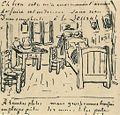Vincent's bedroom in Arles

|
| Bedroom in Arles (First Version) |
|---|
| Vincent van Gogh , 1888 |
| Oil on canvas |
| 72 × 90 cm |
| Van Gogh Museum , Amsterdam |
The bedroom in Arles or Vincent's bedroom is the title of three oil paintings and two drawings in letters that the Dutch painter Vincent van Gogh created between 1888 and 1889 in the so-called Yellow House in Arles .
Image description
The room is very simply furnished, a bed, two chairs and a table. Everything looks very rustic and almost bare. There is no person in the room. The pictures show how the painter lived and the friendships he had. Three portraits (including a self-portrait) and a mirror hang on the walls.
As is typical for Gogh, the colors are applied very thickly and roughly, with thick black dividing lines in between. Although the painter said that it should be a picture in which the eye can find rest, the gaze keeps jumping back and forth between the strong contrasts. The ductus follows the shape of the objects, which means that different directions come into the picture. The parquet flies back, the edge of the bed swings up and down. The profile strips of the door do not fit into the lines of the vanishing point and the bed protrudes into the door frame, which, however, is not due to the painter's negligence. The interpretation as a sign of Van Gogh's beginning madness can also be ruled out here: cadastral plans for the city of Arles show that the Yellow House, which was damaged in the Second World War and later demolished, and Vincent's bedroom had a non-rectangular floor plan.
The portraits of Eugène Boch and Paul-Eugène Milliet hang over the bed .
The picture should be the opposite of Van Gogh's " The Night Café " , which has a sharp contrast between red and green. Here the painter used the complementary colors ocher yellow and violet, which are more calming than the signal colors.
The various paintings are in the Van Gogh Museum in Amsterdam , the Musée d'Orsay in Paris and the Art Institute of Chicago , one of the sketches in the Pierpont Morgan Library .
Vincent's bedroom in Arles
1889
Musée d'Orsay , ParisVan Gogh's bedroom
1889
Art Institute of Chicago
Color changes
In numerous letters, van Gogh always wrote of the color violet (lilac) used in the various paintings. From today's perspective, the three paintings show blue to light blue walls. In the spring of 2016, after years of research , a team from the Art Institute of Chicago announced the likely reason for the different color descriptions: the colors faded through exposure to light and, in particular, the violet reacts to a blue. A laboratory worker had examined blue particles of paint from the Chicago picture and, after turning them over, discovered that their backs were still purple. Investigations on the other two versions of the painting confirmed this result.
In addition to chemical processes within and between the color mixtures and the natural UV radiation of sunlight, museum lighting is assumed to be another main cause of this effect. Some researchers are already warning about certain LED lights. Already at the beginning of 2013 it became known that Van Gogh's favorite yellow, depending on the color mix , had changed to brown and green tones due to light irradiation in various pictures (including the banks of the Seine [1887, Van Gogh Museum]).
literature
- Ronald Pickvance : Van Gogh in Arles. Exhibition catalog Metropolitan Museum of Art New York, Harry N. Abrams, New York 1884, ISBN 0-87099-376-3
- Arte series "Palettes" by Alain Jaubert, episode "Le Haute Note Jaune. Le chambre à Arles". La Sept / Musée d´Orsay / Delta Image 1993. 30 min.
Web links
- The oil painting from 1888 in gigapixel resolution in the Google Art Project .
- Description (English)
Individual evidence
- ↑ Bedroom in Arles: Researchers Discover True Color in Van Gogh Paintings , Spiegel Online, February 15, 2016, accessed August 6, 2016
- ↑ Warning about LED strips: light discolors painting by van Gogh , Spiegel Online from January 4, 2013, accessed on August 6, 2016



